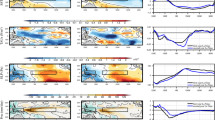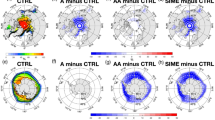Abstract
The interannual variability of Indian summer monsoon rainfall (ISMR) have been examined in association with the variability of 2-metre surface temperature (2mST), and lower- and upper-tropospheric pressure and wind patterns over the globe using ERA-40 reanalysis dataset. The analysis of 44-years (1958–2001) data reveals a recurrent negative phase of ENSO (La Niña) pattern. The increase in 2mST over tropical southwest Pacific and intensification of subtropical westerly jet stream over Indian Ocean due to the consequence of thermal wind balance. The intensification of jet forms anticyclonic anomaly which intensifies Mascarene High as the atmospheric response is equivalent barotropic over there. The Mascarene High intensifies the cross equatorial flow and hence Indian summer monsoon (ISM) circulation. While, during non-ENSO years data reveals a recurrent positive relationship of ISMR with 2mST anomaly over northwest of North Atlantic and intensification and shift of North Atlantic westerly jet stream to higher latitudes. The jet stream intensifies the meridional vorticity dipole, formed due to Azores High and the entrance of Asian subtropical westerly jet stream over North Atlantic and west Mediterranean Sea. A wave activity flux for stationary Rossby waves diverges out of the vorticity dipole toward downstream along the Asian jet stream over the Eurasian region. The jet stream acts as a wave guide and the successive troughs and ridges of the Rossby waves travel along the jet and influence upper-tropospheric Tibetan High and hence ISM circulation.










Similar content being viewed by others
References
Ambrizzi T, Hoskins BJ, Hsu H-H (1995) Rossby Wave Propagation and Teleconnection Patterns in the Austral Winter. J Atmos Sci 52:3661–3672
Angell JK (1981) Comparison of variations in atmospheric quantities with sea surface temperature variations in the equatorial eastern Pacific. Mon Weather Rev 109:230–243
Annamalai H, Liu P (2005) Response of the Asian summer monsoon to changes in El Niño properties. Quart J Roy Met Soc 131:805–831
Ashok K, Guan Z, Yamagata T (2001) Impact of the Indian Ocean Dipole on the relationship between the Indian monsoon rainfall and ENSO. Geophys Res Lett 28:4499–4502
Bamzai AS, Shukla J (1999) Relationship between Eurasian snow cover, snow depth, and the Indian summer monsoon: An observational study. J Clim 12:3117–3132
Blanford HH (1884) On the connection of Himalayan snowfall and seasons of drought in India. Proc R Soc London 37:3–22
Bond NA, Harrison DE (2006) ENSO’s Effect on Alaska during Opposite Phases of the Arctic Oscillation. Int J Climatol 26:1821–1841
Brankovic C, Palmer TN (2000) Seasonal skill and predictability of ECMWF PROVOST ensembles. Quart J Roy Meteor Soc 126:2035–2067
Branstator G (2002) Circumglobal teleconnections, the jet stream waveguide, and the north Atlantic oscillation. J Climate 15:1893–1910
Chang C-P, Harr P, Ju J (2001) Possible roles of Atlantic circulations on the weakening Indian monsoon rainfall-ENSO relationship. J Climate 14:2376–2380
Cherchi A, Navarra A (2003) Reproducibility and predictability of Asian summer monsoon in the ECHAM4-GCM. Clim Dyn 20:365–379
Ding Q-H, Wang B (2005) Circumglobal teleconnection in the Northern Hemisphere Summer. J Climate 18:3483–3505
Gadgil S, Asha G (1992) Intraseasonal variation of the summer monsoon. I: Observational aspects. J Meteor Soc Japan 70:517–527
Gadgil S, Vinayachandran PN, Francis PA (2003) Droughts of the Indian summer monsoon: role of clouds over the Indian Ocean. Current Sci 85:1713–1719
Gibson JK, Kallberg P, Uppala S, Hernandez A, Nomura A, Serrano E (1997) ERA description. ECMWF Re-Analysis Project Report Series, vol 1, pp 72. [Available from European Centre for Medium-Range Weather Forecasts, Shinfield Park, Reading RG29AX, United Kingdom]
Goswami BN, Madhusoodanan MS, Neema CP, Sengupta D (2006) A physical mechanism for North Atlantic SST influence on the Indian summer monsoon. Geophys Res Lett 33:L02706
Hahn D, Shukla J (1976) An apparent relationship between Eurasian snow cover and Indian monsoon rainfall. J Atmos Sci 33:2461–2462
Hoskins BJ, Ambrizzi T (1993) Rossby wave propagation on a realistic longitudinally varying flow. J Atmos Sci 50:1661–1671
Kripalani RH, Kulkarni A (1999) Climatology and variability of historical Soviet snow depth data: some new perspectives in Snow-Indian monsoon teleconnections. Climate Dynamics 15:475–489
Kripalani RH, Kulkarni A (1997a) Climatic impact of El Nino/la Nina on the Indian monsoon: a new perspective. Weather 52:39–46
Kripalani RH, Kulkarni A (1997b) Rainfall variability over Southeast Asia—connections with Indian Monsoon and ENSO extremes: New perspectives. Int J Climatol 17:1155–1168
Kripalani RH, Kulkarni A (1996) Assessing the impacts of El Nino and non—El Nino related droughts over India. Drought Network News 8:11–13
Kripalani RH A, Kulkarni Singh SV (1997) Association of the Indian summer monsoon with northern hemisphere mid-latitude circulation. International Journal of Climatology 17:1055–1067
Kripalani RH, Kulkarni A, Sabade SS (2001) ENSO-monsoon weakening: Is global warming really the player? CLIVAR Exchanges 6:11–18
Krishna Kumar K, Rajagopalan B, Cane MA (1999) On the weakening relationship between the Indian monsoon and ENSO. Science 284:2156–2159
Krishnamurti TN, Bhalme HN (1976) Oscillations of monsoon system. Part I: Observational aspects. J Atmos Sci 45:1937–1954
Krishnamurthy V, Shukla J (2000) Intraseasonal and interannual variability of rainfall over India. J Climate 13:4366–4377
Lu R-Y, Oh J-H, Kim B-J (2002) A teleconnection pattern in upper-level meridional wind over the North African and Eurasian continent in summer. Tellus 54A:44–55
Miyasaka T, Nakamura H (2005) Structure and formation mechanisms of the Northern Hemisphere summertime subtropical highs. J Climate 18(23):5046–5065
Pai DS (2004) A possible mechanism for the weakening of El Nino-monsoon relationship during the recent decade. Met Atmos Phys 86:143–157
Parthasarathy B, Munot AA, Kothawale DR (1995) All India monthly and seasonal rainfall series: 1871–1993. Theor Appl Climatol 49:217–224
Press WH, Flannery BP, Teukolsky SA, Vetterling WT (1992) Numerical Recipes: The Art of Scientific Computing. 2nd edn. Cambridge University Press, pp 611–612
Rajeevan M (2002) Winter surface pressure anomalies over Eurasia and Indian summer monsoon. Geophys Res Lett 29(10):1454
Rajeevan M, Pai DS, Thapliyal V (1998) Spatial and temporal relationships between global land surface air temperature anomalies and Indian summer monsoon. Met Atmos Physics 66:157–171
Ramamurthy K (1969) “Some aspects of “break” in the Indian south-west monsoon during July and August. Forecasting Manual, India Meteorological Department Publication, FMU, Rep. 4, 18.3
Raman CRV, Maliekal JA (1985) A ‘northern oscillation’ relating northern hemispheric pressure anomalies and the Indian summer monsoon? Nature 314:430–432
Raman CRV, Rao YP (1981) Blocking highs over Asia and monsoon droughts over India. Nature 289:271–273
Ramaswamy C (1962) Breaks in the Indian summer monsoon as a phenomenon of interaction between the easterly and the subtropical westerly jet streams. Tellus 14A:337–349
Rasmusson EM, Carpenter TH (1983) The relationship between eastern equatorial Pacific sea surface temperature and rainfall over India and Sri Lanka. Mon Wea Rev 111:517–528
Ropelewski CF, Halpert MS (1987) Global and regional scale precipitation patterns associated with the El Nino/Southern Oscillation. Mon Weather Rev 115:1606–1626
Ropelewski CF, Halpert MS (1989) Precipitation patterns associated with the high index phase of the Southern Oscillation. J Clim 2:268–284
Saji NH, Goswami BN, Vinayachandran PN, Yamagata T (1999) A dipole mode in the tropical Indian Ocean. Nature 401:360–363
Shukla J (1987) Interannual variability of monsoons. In: Monsoons, Fein JS, Stephens PL (eds) Wiley and Sons, New York. Chapter 16:523–548
Sikka (1980) Some aspects of the large-scale fluctuations of summer monsoon rainfall over India in relation to fluctuations in planetary scale circulation parameters. Proc Ind Acad Sci (Earth & Planet Sci) 89:179–195
Sperber KR, Palmer TN (1996) Interannual tropical rainfall variability in general circulation model simulations associated with Atmospheric Model Intercomparison Project. J Climate 9:2727–2750
Sperber KR et al (2001) Dynamical Seasonal Predictability of the Asian Summer Monsoon. Mon Wea Rev 129:2226–2248
Srivastava AK, Rajeevan M, Kulkarni R (2002) Teleconnection of OLR and SST anomalies over Atlantic Ocean with Indian summer monsoon. Geophys Res Lett 29(8):1284
Trenberth KE, Jones PD, Ambenje P, Bojariu R, Easterling D, Klein Tank A, Parker D, Rahimzadeh F, Renwick JA, Rusticucci M, Soden B, Zhai P (2007) Observations: surface and atmospheric climate change. In: Solomon S, Qin D, Manning M, Chen Z, Marquis M, Averyt KB, Tignor M, Millers HL (eds) Climate change 2007: the physical science basis. Contribution of Working Group I to the Fourth Assessment Report of the Intergovernmental Panel on Climate Change. Cambridge University Press, Cambridge, United Kingdom and New York, NY, USA
Uppala SM, Kållberg PW, Simmons AJ, Andrae U, da Costa Bechtold V, Fiorino M, Gibson JK, Haseler J, Hernandez A, Kelly GA, Li X, Onogi K, Saarinen S, Sokka N, Allan RP, Andersson E, Arpe K, Balmaseda MA, Beljaars ACM, van de Berg L, Bidlot J, Bormann N, Caires S, Chevallier F, Dethof A, Dragosavac M, Fisher M, Fuentes M, Hagemann S, Hólm E, Hoskins BJ, Isaksen L, Janssen PAEM, Jenne R, McNally AP, Mahfouf J-F, Morcrette J-J, Rayner NA, Saunders RW, Simon P, Sterl A, Trenberth KE, Untch A, Vasiljevic D, Viterbo P, Woollen J (2005) The ERA–40 re-analysis. Quart J R Meteorol Soc 131:2961–3012
Wallace JM (1983) The climatological mean stationary waves: observational evidence. In: Hoskins BJ, Pearce PR (eds) Large-scale dynamical processes in the atmosphere. Academic Press, pp 27–53
Webster PJ, Palmer TN (1997) The past and the future of EL Nino. Nature 390:562–564
White GH (1982) An observational study of the Northern Hemisphere extratropical summertime general circulation. J Atmos Sci 39:24–40
Acknowledgments
The author is grateful to the Director, Indian Institute of Tropical Meteorology (IITM), and Head, Climatology and Hydrometeorology Division (C&H Div.), IITM for their constant encouragement and for providing the necessary facilities to carry out this study.
Author information
Authors and Affiliations
Corresponding author
Rights and permissions
About this article
Cite this article
Yadav, R.K. Role of equatorial central Pacific and northwest of North Atlantic 2-metre surface temperatures in modulating Indian summer monsoon variability. Clim Dyn 32, 549–563 (2009). https://doi.org/10.1007/s00382-008-0410-x
Received:
Accepted:
Published:
Issue Date:
DOI: https://doi.org/10.1007/s00382-008-0410-x




